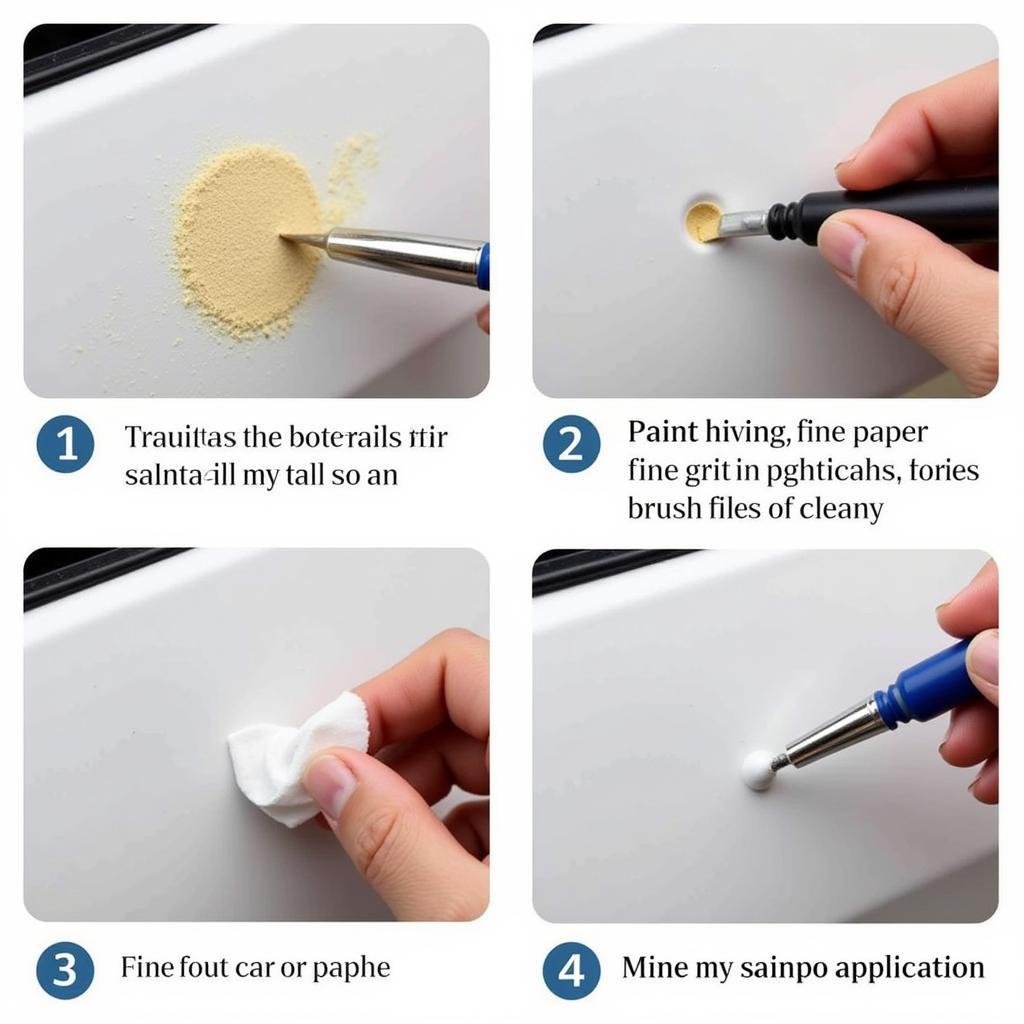Car paint chips are an unfortunate reality of vehicle ownership. Whether from rocks, road debris, or even minor bumps, these small blemishes can detract from your car’s appearance and, if left untreated, lead to rust. Knowing how to repair chips in paint on cars is a valuable skill that can save you money and maintain your vehicle’s value. This guide will walk you through the process, from assessing the damage to achieving a professional-looking repair.
Looking for a quick fix for minor scratches? Check out car paint repair crayon.
Assessing the Damage: A Crucial First Step
Before you begin any repairs, you need to determine the extent of the damage. Is it a superficial scratch, a chip that’s penetrated the primer, or a deep gouge that’s exposed the bare metal? The depth of the damage dictates the appropriate repair method. For light scratches, a simple touch-up paint may suffice. However, deeper chips will require more involved steps, including cleaning, priming, and careful paint application.
Gathering Your Supplies: The Right Tools for the Job
Having the right tools and materials is essential for a successful paint chip repair. You’ll need:
- Automotive touch-up paint (matched to your car’s color code)
- Primer (if the chip has reached the metal)
- Fine-grit sandpaper (e.g., 2000-grit)
- Rubbing compound
- Polishing compound
- Wax
- Clean microfiber cloths
- Masking tape
- Isopropyl alcohol
- Applicator brush or toothpick
Repairing the Chip: A Step-by-Step Guide
- Clean the Area: Thoroughly clean the chipped area with isopropyl alcohol to remove dirt, wax, and grease. This ensures proper adhesion of the repair materials.
- Sand (If Necessary): If the chip is rough or has rust, carefully sand the area with fine-grit sandpaper. Be gentle to avoid further damage to the surrounding paint.
- Prime (If Necessary): If the chip has reached the metal, apply a thin layer of automotive primer to the exposed area. Let the primer dry completely before proceeding.
- Apply Touch-Up Paint: Using a fine-tipped brush or toothpick, carefully apply the touch-up paint to the chip. Apply multiple thin coats, allowing each coat to dry before applying the next. Avoid applying too much paint, as this can lead to drips and an uneven finish.
- Level the Paint (If Necessary): If the paint builds up higher than the surrounding surface, you can carefully level it with fine-grit sandpaper after it has dried completely. This step requires patience and a light touch.
- Compound and Polish: Once the paint is dry and leveled, use rubbing compound followed by polishing compound to blend the repaired area with the surrounding paint. Apply the compounds in small circular motions using a clean microfiber cloth.
- Wax: Finally, apply a coat of wax to the repaired area and the surrounding paint to protect and enhance the shine.
If you’re looking for professional help in the Denver area, consider [car paint chip repair denver](https://carrepairon.com/car paint-chip-repair-denver/).
Preventing Future Chips: Protecting Your Car’s Paint
Preventing paint chips altogether is impossible, but you can take steps to minimize the risk:
- Maintain a Safe Following Distance: This reduces the chance of rocks and debris being kicked up by the vehicle in front of you.
- Wash Your Car Regularly: Regular washing removes abrasive dirt and grime that can scratch the paint.
- Wax Your Car Regularly: Wax provides a protective layer against minor scratches and chips.
- Park in Covered Areas When Possible: This protects your car from the elements and reduces exposure to potential hazards.
For minor paint repairs, you might want to check out minor car paint repair near me. If you’re located in Deland, Florida, and prefer mobile service, consider mobile car paint scratch repair deland fl.
Conclusion: Maintaining Your Car’s Appearance and Value
Repairing paint chips is a straightforward process that can significantly improve your car’s appearance and protect it from further damage. By following these steps and using the right materials, you can achieve professional-looking results and maintain your car’s value. How to repair chips in paint on cars becomes a less daunting task when armed with the correct information and a little patience.
FAQ
- How long does it take for touch-up paint to dry? Typically, touch-up paint dries to the touch in 30-60 minutes, but it may take several hours or even days to fully cure.
- Can I use nail polish to repair a paint chip? While tempting, nail polish is not formulated for automotive paint and may not adhere properly or match the color correctly. It’s best to use automotive touch-up paint.
- How do I find my car’s paint code? The paint code is usually located on a sticker inside the driver’s side doorjamb, under the hood, or in the owner’s manual.
- What if the chip is very large? For very large chips or areas of damage, it’s best to consult a professional auto body repair shop.
- Can I repair a paint chip in direct sunlight? No, direct sunlight can cause the paint to dry too quickly and unevenly. It’s best to repair the chip in a shaded area.
- Can I wash my car after repairing a paint chip? It’s best to wait at least 24 hours after the repair before washing your car.
- How can I prevent rust in a chipped area? Addressing the chip promptly by cleaning and sealing the exposed metal with primer and touch-up paint is the best way to prevent rust.
Considering an alternative repair method? You might find car paste painting to repair dents interesting.
Have questions about other car repairs? We’re here to help! Contact us via WhatsApp at +1(641)206-8880 or email us at [email protected]. Our customer service team is available 24/7.


